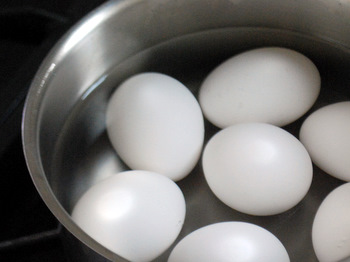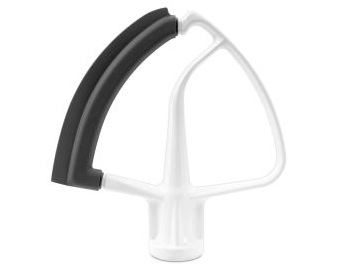
Many recipes call for room temperature or softened butter because it is easier to incorporate into a cake batter or cookie dough than rock hard, cold butter is. The same is true of eggs, even though most recipes don’t specifically call for eggs to be at room temperature. Refrigeration keeps eggs fresher for a much longer period of time than storing them at room temperature, but they will blend into recipes much more easily if you take the time to take the chill off of them before using them. Eggs at room temperature will have more “relaxed” whites that take on more volume when beaten and break up more easily when whisked into a batter. Cold eggs can actually cause the butter you carefully softened to firm up and give a batter a slightly curdled appearance (although it is usually just fine to keep going with a recipe when that happens).
To bring eggs to room temperature, you can take them out of the refrigerator about 30 minutes before you plan to use them (around the time that you might take your butter out of the fridge) and leave them on the countertop. If the eggs sit out longer than that, it won’t hurt them in terms of how they act in the recipe, but they will have “aged” compared to eggs that have been kept only in the refrigerator.
If you forget to take your eggs out of the refrigerator, you can warm them up very quickly by placing them in a bowl full of warm water. Just 5 or 10 minutes in a bowl full of warm water – hot water may cause the egg shells to crack – will take the chill off of your eggs.
Recipes that call for egg whites alone often call for them to be at room temperature. Eggs are, however, much easier to separate when they are cold. To warm up just your egg whites or egg yolks, separate the eggs when cold and place the whites and yolks in small bowls. Place these bowls into slightly larger bowls full of warm water and allow them to sit for 5-10 minutes (or simply let them sit, covered, at room temperature for 30-60 minutes before using). Leftover egg whites or egg yolks can be stored for later use.






Linda
February 24, 2011I do this frequently since I tend to bake by muse and the eggs aren’t warm enough for the recipe. Works great. Another great idea!!
Jim
February 25, 2011Odd – here in Europe, the eggs are never refrigerated. They’re just there on the shelf, or in the marketplace in racks. After 12 years here I’ve never had a bad egg yet…
Sean
February 27, 2011My inlaws have chickens and they keep a basket of eggs for breakfast every morning. That I know of they are never refrigerated. Now if I could only get them to bring some over every time I plan on baking…
Jennifer J-W
February 28, 2011I use this same method to warm my eggs. I also cut the butter into smaller pieces to bring it up to room temp. I’ve heard it’s bad to microwave butter (even at lower temps) as it can have hot spots and it is way too easy to overdo it…
Stephanie
February 28, 2011I LOVE your blog, but can you PLEASE make an easier way to look through the recipes. 5 at a time stinks. maybe a long list with a mini picture next to it like some other blogs.
Donna
December 9, 2012The egg warming tip is so useful. Thank you. Now, please tell me how to keep springerli dough from being so sticky after all is mixed and it is ready to pat into shape and place in the refrigerator. Would it help/hurt to use 5 instead of 6 eggs this recipe requires?
Lulu
May 1, 2013@Jim I also live in Europe, and that is not true. All of the eggs are in the refrigerated section.
Marnee
November 8, 2015@Jim@Lulu. Here in Spain the eggs are NEVER in the refrigerated section.